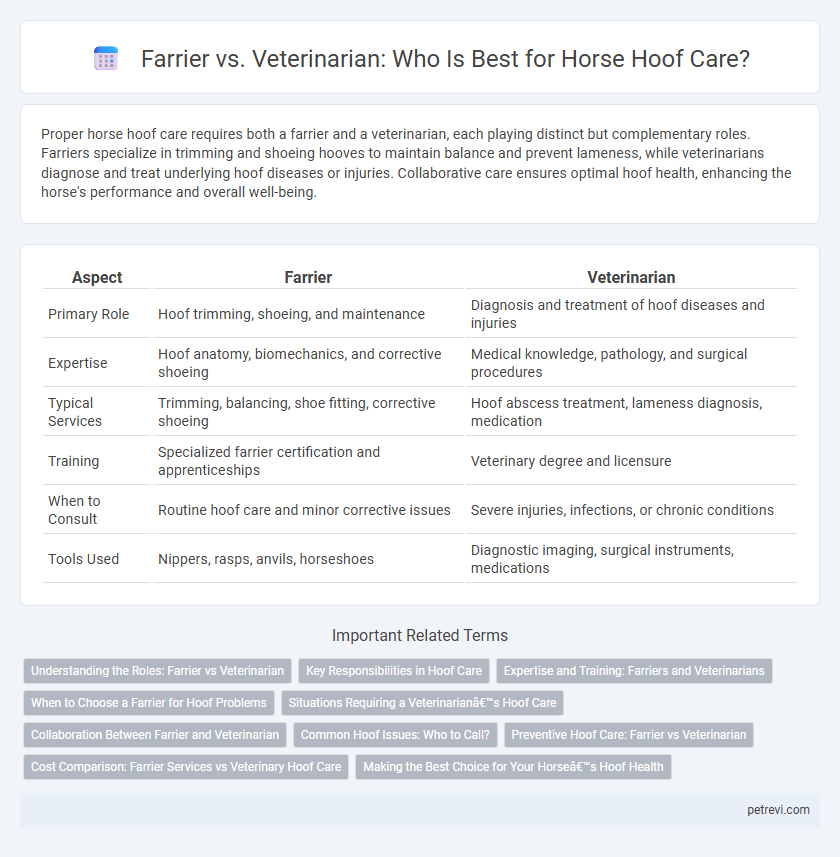Proper horse hoof care requires both a farrier and a veterinarian, each playing distinct but complementary roles. Farriers specialize in trimming and shoeing hooves to maintain balance and prevent lameness, while veterinarians diagnose and treat underlying hoof diseases or injuries. Collaborative care ensures optimal hoof health, enhancing the horse's performance and overall well-being.
Table of Comparison
| Aspect | Farrier | Veterinarian |
|---|---|---|
| Primary Role | Hoof trimming, shoeing, and maintenance | Diagnosis and treatment of hoof diseases and injuries |
| Expertise | Hoof anatomy, biomechanics, and corrective shoeing | Medical knowledge, pathology, and surgical procedures |
| Typical Services | Trimming, balancing, shoe fitting, corrective shoeing | Hoof abscess treatment, lameness diagnosis, medication |
| Training | Specialized farrier certification and apprenticeships | Veterinary degree and licensure |
| When to Consult | Routine hoof care and minor corrective issues | Severe injuries, infections, or chronic conditions |
| Tools Used | Nippers, rasps, anvils, horseshoes | Diagnostic imaging, surgical instruments, medications |
Understanding the Roles: Farrier vs Veterinarian
Farriers specialize in hoof trimming, shoeing, and correcting hoof-related issues to maintain proper hoof health and improve a horse's performance. Veterinarians diagnose and treat medical conditions affecting the hooves, such as infections, laminitis, or injuries, using medical interventions and advanced diagnostics. Collaboration between farriers and veterinarians ensures comprehensive hoof care, combining mechanical hoof maintenance with medical treatment for optimal equine foot health.
Key Responsibilities in Hoof Care
Farriers specialize in trimming and balancing horse hooves, applying horseshoes to protect the hoof and improve gait, and managing common hoof problems such as cracks and thrush. Veterinarians focus on diagnosing and treating complex hoof diseases, infections, and lameness issues that require medical intervention or surgery. Collaboration between farriers and veterinarians ensures comprehensive hoof care through routine maintenance and advanced medical treatment.
Expertise and Training: Farriers and Veterinarians
Farriers specialize in hoof care, combining blacksmithing skills with detailed knowledge of equine hoof anatomy, gained through apprenticeships and certification programs. Veterinarians undergo extensive medical training in equine health, addressing hoof diseases, injuries, and systemic conditions affecting hooves. Collaborative efforts between farriers and veterinarians optimize hoof care, blending mechanical skill with medical expertise to ensure equine well-being.
When to Choose a Farrier for Hoof Problems
Choosing a farrier for horse hoof care is ideal when routine trimming, shoeing, and basic hoof maintenance are required to prevent common issues like cracks, chips, or overgrowth. Farriers specialize in balancing the hoof, applying corrective shoes, and managing stress-related hoof conditions, making them essential for regular preventive care and minor hoof problems. For more complex or systemic hoof diseases such as laminitis or abscesses, involving a veterinarian is crucial for diagnosis and medical treatment.
Situations Requiring a Veterinarian’s Hoof Care
Situations requiring a veterinarian's hoof care include severe hoof infections such as laminitis, deep abscesses, or fractures that compromise the horse's mobility and overall health. Veterinarians possess specialized knowledge for diagnosing and treating hoof diseases using medical interventions, imaging, and surgical techniques beyond the scope of routine farrier services. Coordinated care between veterinarians and farriers is essential in complex cases to ensure optimal recovery and prevent chronic lameness.
Collaboration Between Farrier and Veterinarian
Effective horse hoof care relies on the collaboration between farriers and veterinarians, combining the farrier's expertise in trimming and shoeing with the veterinarian's medical knowledge to address underlying health issues. Regular communication ensures early detection and treatment of hoof diseases such as laminitis and navicular syndrome, enhancing overall equine hoof health. This partnership promotes preventive care, timely intervention, and customized treatment plans tailored to each horse's specific needs.
Common Hoof Issues: Who to Call?
Common horse hoof issues such as thrush, cracks, and laminitis require distinct expertise: farriers specialize in trimming and shoeing to maintain hoof balance and prevent structural problems, while veterinarians diagnose and treat infections, injuries, and metabolic disorders. In cases of lameness or sudden changes in gait, consulting a veterinarian is crucial for accurate diagnosis and medical intervention. Routine hoof maintenance and minor concerns should be managed by a farrier to ensure optimal hoof health and prevent more serious complications.
Preventive Hoof Care: Farrier vs Veterinarian
Preventive hoof care for horses involves regular trimming, shoeing, and monitoring hoof health to avoid lameness and infections. Farriers specialize in routine hoof maintenance, balancing, and corrective shoeing essential for everyday hoof function and prevention of common issues like cracks or thrush. Veterinarians focus on diagnosing and treating more serious hoof diseases, injuries, and systemic conditions that impact hoof health, often working alongside farriers for comprehensive preventive care.
Cost Comparison: Farrier Services vs Veterinary Hoof Care
Farrier services for horse hoof care typically cost between $30 and $150 per visit, depending on the complexity of the trimming or shoeing required. Veterinary hoof care, often necessary for injuries or infections, can range from $150 to over $500 due to diagnostic tests, medications, and specialized treatments. Choosing between farrier and veterinarian services depends on the horse's condition, with farriers providing routine maintenance at lower costs and veterinarians addressing more severe hoof health issues.
Making the Best Choice for Your Horse’s Hoof Health
Choosing between a farrier and a veterinarian for horse hoof care depends on the specific needs of the horse's hoof health. Farriers specialize in trimming, balancing, and shoeing hooves to prevent lameness and improve performance, while veterinarians diagnose and treat underlying medical conditions affecting the hoof. For optimal hoof health, collaboration between a skilled farrier and a knowledgeable veterinarian ensures comprehensive care, addressing both routine maintenance and medical issues.
Farrier vs Veterinarian for Horse Hoof Care Infographic

 petrevi.com
petrevi.com